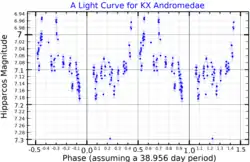 A light curve for KX Andromedae, plotted from Hipparcos data,[1] folded with the period published by Koen and Eyer (2002)[2] | |
| Observation data Epoch J2000 Equinox J2000 | |
|---|---|
| Constellation | Andromeda |
| Right ascension | 23h 07m 06.2120s[3] |
| Declination | +50° 11′ 32.4891″[3] |
| Apparent magnitude (V) | 6.88 – 7.28 variable[4] |
| Characteristics | |
| Spectral type | B3pe+K1III[5] |
| Apparent magnitude (U) | 6.79[6] |
| Apparent magnitude (B) | 7.25[6] |
| Apparent magnitude (V) | 6.92[6] |
| Apparent magnitude (G) | 6.8227[3] |
| Apparent magnitude (J) | 5.845[7] |
| Apparent magnitude (H) | 5.33[6] |
| Apparent magnitude (K) | 5.19[6] |
| Variable type | Be star |
| Astrometry | |
| Radial velocity (Rv) | −7.8±0.9[8] km/s |
| Proper motion (μ) | RA: 1.697±0.057 [3] mas/yr Dec.: −0.788±0.048[3] mas/yr |
| Parallax (π) | 1.2444 ± 0.0328 mas[3] |
| Distance | 2,620 ± 70 ly (800 ± 20 pc) |
| Orbit[9] | |
| Period (P) | 38.919 days |
| Eccentricity (e) | 0±0.03 |
| Inclination (i) | 50±5° |
| Periastron epoch (T) | HJD 2423220.25±0.09 |
| Semi-amplitude (K2) (secondary) | 86.2±0.8 km/s |
| Details | |
| Primary | |
| Mass | 9.0±0.1[10] M☉ |
| Age | 22.4±3.1[10] Myr |
| Secondary | |
| Radius | 19±4[9] R☉ |
| Surface gravity (log g) | 2.0±0.5[9] cgs |
| Temperature | 5000±400[9] K |
| Rotational velocity (v sin i) | 25±5[9] km/s |
| Other designations | |
| Database references | |
| SIMBAD | data |
KX Andromedae (often abbreviated to KX And) is a spectroscopic binary star in the constellation Andromeda. Its apparent visual magnitude varies between 6.88 and 7.28.[4]
The primary component of the KX Andromedae system is a Be star with a spectral classification B3pe as in 2017,[4] although on historical record it has varied from B1 to B7.[11]
The secondary star is difficult to detect in the spectrum, but has been given a K1III spectral type. It is likely to be an asymptotic giant branch star that fills its Roche lobe.[9]
The system is only about 25 million years old. The pair complete a circular orbit every 38.919 days at an inclination of 50°.[9]
References
- ↑ "/ftp/cats/more/HIP/cdroms/cats". Centre de Données astronomiques de Strasbourg. Strasbourg astronomical Data Center. Retrieved 15 October 2022.
- ↑ Koen, Chris; Eyer, Laurent (March 2002). "New periodic variables from the Hipparcos epoch photometry". Monthly Notices of the Royal Astronomical Society. 331 (1): 45–59. arXiv:astro-ph/0112194. Bibcode:2002MNRAS.331...45K. doi:10.1046/j.1365-8711.2002.05150.x.
- 1 2 3 4 5 6 Brown, A. G. A.; et al. (Gaia collaboration) (August 2018). "Gaia Data Release 2: Summary of the contents and survey properties". Astronomy & Astrophysics. 616. A1. arXiv:1804.09365. Bibcode:2018A&A...616A...1G. doi:10.1051/0004-6361/201833051. Gaia DR2 record for this source at VizieR.
- 1 2 3 KX And, database entry, Combined General Catalog of Variable Stars (GCVS5.1, 2017 Ed.), N. N. Samus, O. V. Durlevich, et al., CDS ID II/250 Accessed on line 2018-10-17.
- 1 2 3 4 5 Database entry, Catalogue of Stellar Photometry in Johnson's 11-color system (2002 Ed.), J. R. Ducati, CDS ID II/237 Accessed on line 2018-11-10.
- ↑ Cutri, Roc M.; Skrutskie, Michael F.; Van Dyk, Schuyler D.; Beichman, Charles A.; Carpenter, John M.; Chester, Thomas; Cambresy, Laurent; Evans, Tracey E.; Fowler, John W.; Gizis, John E.; Howard, Elizabeth V.; Huchra, John P.; Jarrett, Thomas H.; Kopan, Eugene L.; Kirkpatrick, J. Davy; Light, Robert M.; Marsh, Kenneth A.; McCallon, Howard L.; Schneider, Stephen E.; Stiening, Rae; Sykes, Matthew J.; Weinberg, Martin D.; Wheaton, William A.; Wheelock, Sherry L.; Zacarias, N. (2003). "VizieR Online Data Catalog: 2MASS All-Sky Catalog of Point Sources (Cutri+ 2003)". CDS/ADC Collection of Electronic Catalogues. 2246: II/246. Bibcode:2003yCat.2246....0C.
- ↑ Pourbaix, D.; et al. (September 2004), "SB9: The ninth catalogue of spectroscopic binary orbits", Astronomy and Astrophysics, 424 (2): 727–732, arXiv:astro-ph/0406573, Bibcode:2004A&A...424..727P, doi:10.1051/0004-6361:20041213, S2CID 119387088.
- 1 2 3 4 5 6 7 Tarasov, A. E.; Berdyugina, S. V.; Berdyugin, A. V. (May 1998), "The massive interacting binary KX And: The orbit and physical parameters of the secondary component", Astronomy Letters, 24 (3): 316–320, Bibcode:1998AstL...24..316T
- 1 2 Tezlaff, N.; Neuhäuser, R.; Hohle, N. N. (January 2011), "A catalogue of young runaway Hipparcos stars within 3 kpc from the Sun", Monthly Notices of the Royal Astronomical Society, 410 (1): 190–200, arXiv:1007.4883, Bibcode:2011MNRAS.410..190T, doi:10.1111/j.1365-2966.2010.17434.x, S2CID 118629873
- ↑ Koubský, P.; Harmanec, P.; Brož, M.; Kotková, L.; Yang, S.; Božić, H.; Sudar, D.; Frémat, Y.; Korčáková, D.; Votruba, V.; Škoda, P.; Šlechta, M.; Ruždjak, D. (2019), "Properties and nature of be stars", Astronomy & Astrophysics, 629: A105, arXiv:1908.02719, doi:10.1051/0004-6361/201834597, S2CID 199472856
This article is issued from Wikipedia. The text is licensed under Creative Commons - Attribution - Sharealike. Additional terms may apply for the media files.